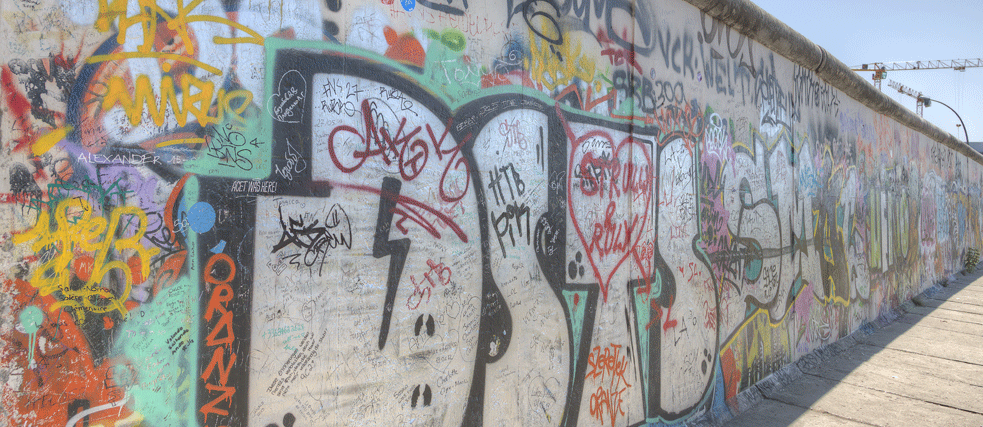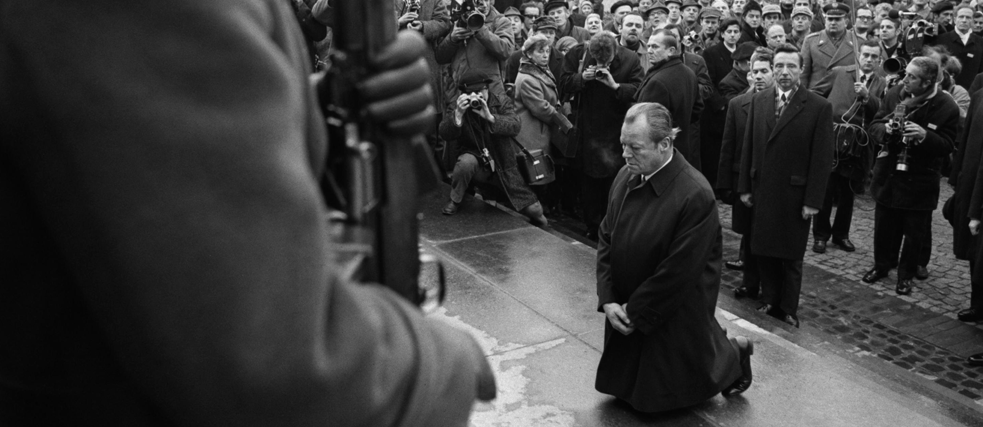Shared history
Sites of memory

Sites of memory play a central role in forming a collective memory of history. Precisely because they appear unambiguous only at first glance, they are ideally suited to lessons in German as a foreign or second language: engaging with them provides an opportunity to experience and reflect upon the interpretive power of language and the complexity and heterogeneity of culture.
In 2007, a volume by Schmidt/Schmidt entitled Erinnerungsorte. Deutsche Geschichte im DaF-Unterricht (i.e. Sites of memory. German history in GFL teaching) was published – the first clear indication of the growing attention paid to the term in the teaching of German as a foreign or second language. The concept itself is related to theories of collective memory based on the ground-breaking ideas of the French sociologist Maurice Halbwachs in the 1920s. One fundamental aspect of this is the realization that such seemingly individual phenomena as memory and recollection in fact exhibit a deeply social character. For example, not only are individual memories dependent on communicative contexts; memory is also a social phenomenon in the sense that families, groups and indeed entire nations create memories that are constructed and passed on through communicative activities such as story-telling, through institutions such as schools, and through rituals such as regularly recurring days of commemoration: “memory”, explains cultural scientist Jan Assmann (1999: 35), “only develops in a person during the process of his or her socialization.” (translated from German).
How “sites of memory” come about
When retelling the history of France according to its sites of memory in a book he wrote in the 1980s entitled Les Lieux de mémoire (translated into English as Realms of Memory), the French historian Pierre Nora based his work on the ideas outlined above. In this context, he understood sites of memory to be “places – in all senses of the word – [...] in which the memory of the nation of France has become condensed, embodied or crystallized to a particular degree” (Nora 1998: 7; translated from German). This referred by no means only to places in the everyday meaning of the word, but also to events, persons, institutions, texts and expressions of high emotional and symbolic relevance for the way French society perceives and understands itself. Sites of memory are not always places in the conventional sense. | Photo (detail): John © Adobe Stock
Sites of memory are not always places in the conventional sense. | Photo (detail): John © Adobe Stock
 Sites of memory can be particular persons, texts or even objects. | Photo (detail): pureshot © Adobe Stock
Sites of memory can be particular persons, texts or even objects. | Photo (detail): pureshot © Adobe Stock
 Willy Brandt’s genuflection at the Warsaw Ghetto Memorial is a German-Polish site of memory. | Photo: © Bundesregierung / Engelbert Reineke
Willy Brandt’s genuflection at the Warsaw Ghetto Memorial is a German-Polish site of memory. | Photo: © Bundesregierung / Engelbert Reineke
Sites of memory in the context of GFL and GSL
The numerous publications, practical experience reports and didactic proposals (see the contributions in Badstübner-Kizik/Hille 2015 and 2016; Fornoff 2009; Roche/Röhling 2014, Dobstadt/Magosch 2016) that have appeared in recent years are evidence of the wide range of possible applications for the concept in foreign and second language didactic contexts. Its potential stems from the possibility to use the example of individual sites of memory to discover not only their turbulent past but also and above all their – generally controversial – contemporary meanings. This gives a nuanced insight into discourses in which German-speaking societies address their identity and what binds them together symbolically. Against this backdrop it is noticeable that particular attention has been devoted in recent years to what are known as “shared” sites of memory: those that mean something different in various societies. This is a reminder of the fact that sites of memory cannot in many cases be clearly attributed to one specific nation. Another focus has been on the possibilities of pursuing European work on memory, and on the memory traces of migration in the German-speaking world and of German and European colonial history. This can give rise to interest on various levels in different teaching and learning contexts, be it in mixed European learning groups, when working with migrants in German as a second language lessons, or within the framework of German studies programmes with a postcolonial focus in non-European contexts. That said, it is important to avoid making simple comparisons that entail a risk of homogenization. Talking about “the Russian” versus “the German” view of Stalingrad ignores the fact that there is no such thing as either an unequivocally Russian or unequivocally German view. This ambiguity is a central aspect of sites of memory that is particularly important from a foreign and second language didactic perspective.Added value of sites of memory in GFL/GSL lessons
- Contemporary relevance: When working with sites of memory, one central question is how a society constructs its identity and its orientation when engaging with its past in the (respective) present. From this perspective, history cannot be seen as a finished process but rather as something that “is still happening” (François/Schulze 2005: 12).
- Complexity: Sites of memory appear unambiguous only at first glance. Upon closer examination, they reveal themselves to be complex, ambiguous, contested and controversial; this also reveals the true heterogeneity of societies that from the outside often appear homogenous (cf. Badstübner-Kizik 2015).
- Construct and interpretation character: When engaging with sites of memory, one can learn that reality is not an objective fact but a product of – changing – ascriptions. Sites of memory are the scenes of battles for interpretation and linguistic and cultural predominance. By working with them, learners can develop an understanding of the way in which language and the media construct and shape reality.
- Sites of memory and the dual character of language: When learners examine and attempt to understand sites of memory, they pick up on earlier – often competing – interpretations and process them. When learners are made aware of the resulting tensions between stability and instability, conventionality and creativity, norms and norm violations, they acquire the ability to understand language and communication on a more complex level.
Literature
Assmann, Jan (1999): Das kulturelle Gedächtnis. Schrift, Erinnerung und politische Identität in frühen Hochkulturen. München. (English translation: Beck Assmann, Jan (1999): Cultural Memory and Early Civilization: Writing, Remembrance, and Political Imagination. Cambridge: Cambridge University Press.)
Badstübner-Kizik, Camilla (2015): Über „Erinnerungsorte“ zur Vielfalt des deutschsprachigen Raumes. In: Fremdsprache Deutsch Volume 52, p. 11-14.
Badstübner-Kizik, Camilla / Hille, Almut (2015) (Ed.): Kulturelles Gedächtnis und Erinnerungsorte im hochschuldidaktischen Kontext (= Posener Beiträge zur Angewandten Linguistik; 7), p. 263-273.
Badstübner-Kizik, Camilla/Hille, Almut (2016) (Ed.): Erinnerung im Dialog. Deutsch-Polnische Erinnerungsorte in der Kulturdidaktik Deutsch als Fremdsprache (= Język Kultura Komunikacja; 17).
Dobstadt, Michael / Magosch, Christine (2016): Der ,Erinnerungsort Tschernobyl‘ in deutschsprachigen ästhetischen Texten (Literatur, Film, Musik, Graphic Novel). In: Freudenfeld, Regina et al. (Ed.): In Sprachwelten über-setzen (Mat DaF - Materialien Deutsch als Fremdsprache 95), p.213-232.
François, Etienne/Schulze, Hagen (Ed.) (2005): Deutsche Erinnerungsorte. Eine Auswahl. Bonn: Federal Agency for Civic Education.
Fornoff, Roger (2009): Erinnerungsgeschichtliche Deutschlandstudien in Bulgarien. Theoriekonzepte – unterrichtspraktische Ansätze – Lehrerfahrungen. In: Info DaF Issue 36, Volume 6, p. 499-517.
Nora, Pierre (1998): Zwischen Geschichte und Gedächtnis. Frankfurt/Main: Fischer.
Roche, Jörg/Röhling, Jürgen (2014) (Ed.): Erinnerungsorte und Erinnerungskulturen. Konzepte und Perspektiven für die Sprach- und Kulturvermittlung. Baltmannsweiler (Perspektiven Deutsch als Fremdsprache; 27).
Schmidt, Sabine/Schmidt, Karin (2007): Erinnerungsorte. Deutsche Geschichte im DaF-Unterricht. Materialien und Kopiervorlagen. Berlin: Cornelsen.